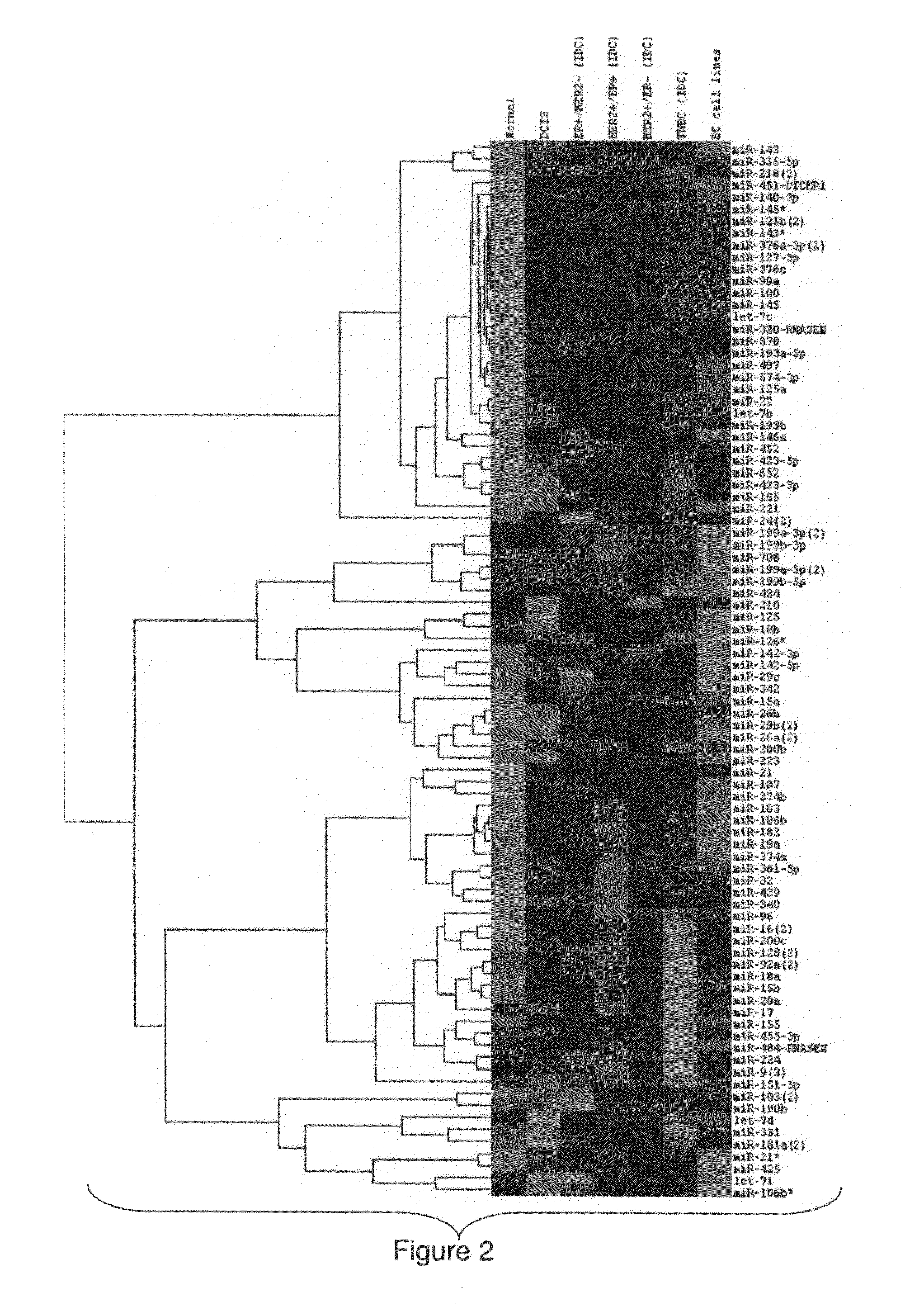Breast Cancer Biomarker Signatures for Invasiveness and Prognosis
a breast cancer and biomarker technology, applied in the field of molecular biology, can solve the problems that the gene expression study of the genome-wide mrna failed to identify the specific gene of the progression stage, and achieve the effect of increasing expression and increasing the risk of progression
- Summary
- Abstract
- Description
- Claims
- Application Information
AI Technical Summary
Benefits of technology
Problems solved by technology
Method used
Image
Examples
example 1
Materials and Methods
[0208]The minimal run complexity of 98,000 reads for optimal representation of breast miRNA profiles were determined, by using Complexity50. The Complexity50 as the median complexity of the nearest-neighbors centered on Representation50 was computed (FIG. 7). Thus, included in this study were only those runs that had complexity larger than Complexity50 (107 samples were retained out of 185). The normalization of the different runs was performed using a modification of RPKM (Mortazavi A, Williams B A, McCue K, Schaeffer L, & Wold B (2008) Mapping and quantifying mammalian transcriptomes by RNA-Seq. Nat. Methods 5(7):621-628). The raw data for some short RNA sequences were obtained from Farazi et al. (2011) MicroRNA Sequence and Expression Analysis in Breast Tumors by Deep Sequencing,” Cancer Res. 71(13):4443-4453.
[0209]Since the lengths of the different miRNA species are almost constant, the miRNA length were not included in the normalization, which thus was simp...
example 2
Prognostic miRNA Signature for Time-to-Metastasis and Overall-Survival in Breast Carcinoma
[0218]The association between miRNAs and prognosis were discovered using two clinical parameters: time-to-metastasis and overall-survival. The differentially expressed miRNAs in the Normal / DCIS, DCIS / IDC transitions and the different IDC subtypes (FIG. 2) were identified.
[0219]miR-127-3p, miR-210, miR-185, miR-143* and let-7b were among the miRNAs significantly associated with time-to-metastasis, as determined by univariate and multivariate analysis (FIG. 17—Table 9).
[0220]miR-210, miR-21, miR-221 and miR-652 were among those correlated with overall-survival (FIG. 18—Table 10), with miR-210, miR-21, miR-106b*, miR-197 and let-7i common to both prognostic signatures. Among these five common miRNAs, miR-210 was the only one present in the invasiveness micro-signature.
[0221]The Kaplan Meier curves for miR-210 in time-to-metastasis is shown in FIG. 3B, and overall-survival of IDC patients is shown ...
example 3
miR-210 and HIF1A Coupling in Breast Cancer Progression
[0224]Since miR-210 is inducible by hypoxia and to regulate genes involved in tumor initiation, analysis was made of HIF1A and the primary RNA for miR-210 (pri-mir-210) in breast cancer progression, using Affymetrix microarray data. The data show a very good correlation between HIF1A and pri-mir-210 RNA (p<0.001).
[0225]Each BC subtype for the relative amounts of mature miR-210, pri-mir-210 and HIF1A was compared (FIG. 4). The mature miR-210 expression is shown alongside that of pri-mir-210 and HIF1A RNA, for each BC subtype and for normal breast. The RNA measures are indicated as percent of the total, for each RNA, within the groups. The levels of HIF1A, pri-mir-210, and mature miR-210 were always maximal in the HER2+ / ER− tumors, while the lowest levels of HIF1A and pri-mir-210 were in normal breast. Levels of HIF1A are believed to indicate hypoxia, and the low level of HIF1A in normal breast tissue was in agreement with normoxi...
PUM
| Property | Measurement | Unit |
|---|---|---|
| molecular weight | aaaaa | aaaaa |
| molecular weight | aaaaa | aaaaa |
| time | aaaaa | aaaaa |
Abstract
Description
Claims
Application Information
 Login to View More
Login to View More - R&D
- Intellectual Property
- Life Sciences
- Materials
- Tech Scout
- Unparalleled Data Quality
- Higher Quality Content
- 60% Fewer Hallucinations
Browse by: Latest US Patents, China's latest patents, Technical Efficacy Thesaurus, Application Domain, Technology Topic, Popular Technical Reports.
© 2025 PatSnap. All rights reserved.Legal|Privacy policy|Modern Slavery Act Transparency Statement|Sitemap|About US| Contact US: help@patsnap.com



